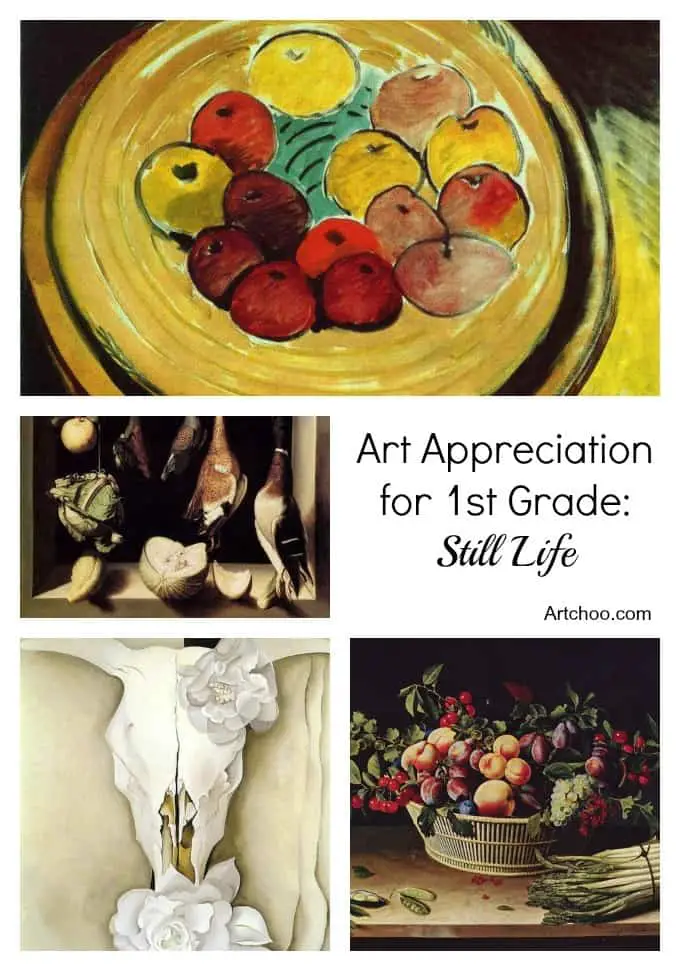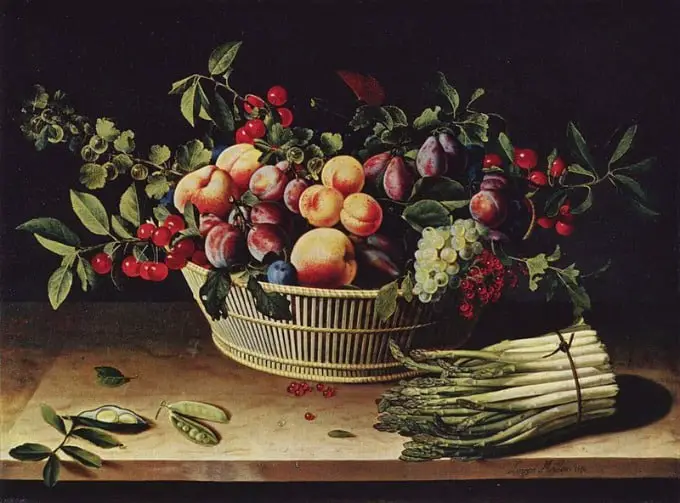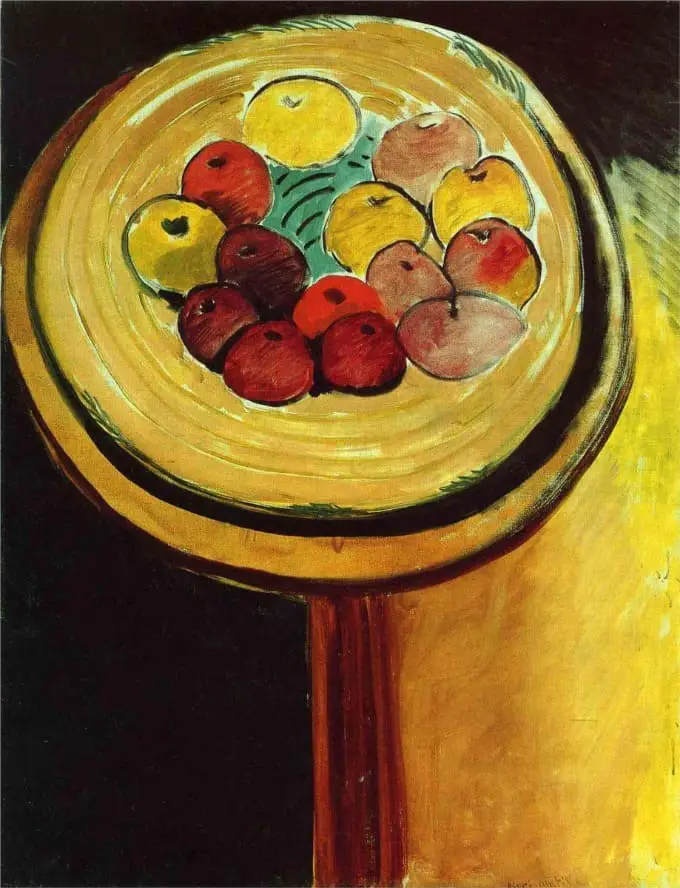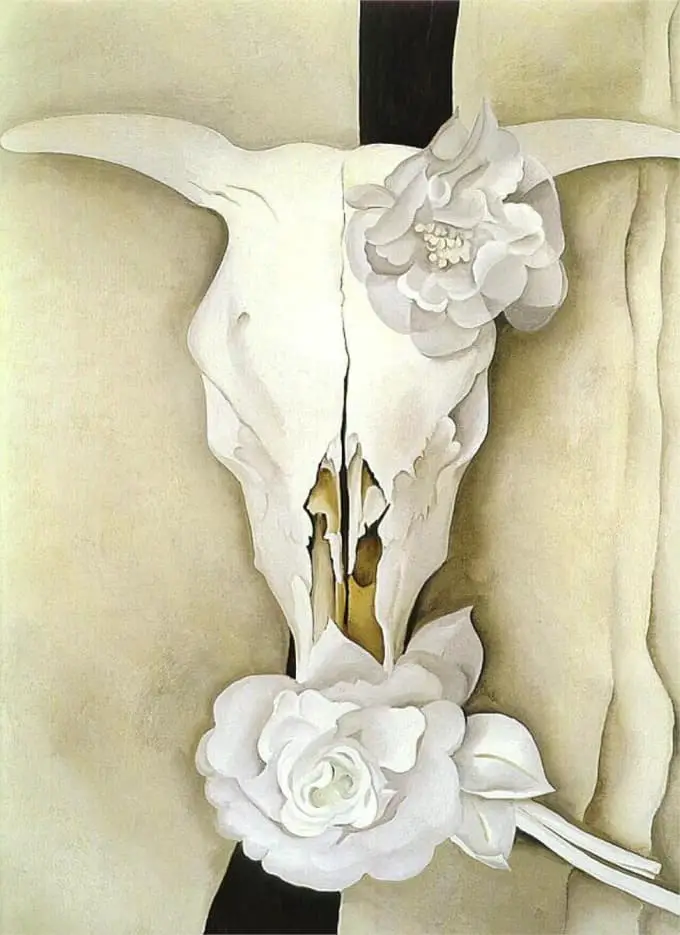
Still life paintings are something many kids have seen at this point, but not discussed. Here you get a wide range of paintings to chat about and compare with your kids. Which on is your favorite? I’m loving that crazy-dramatic light in the Cotan painting.
Introduction: A “still life” is a painting or drawing of non-living objects like bowls, cut flowers, vegetables, bottles, vases, etc. Usually there are no people in a still life composition. Does that sound like it could be boring? It’s not. There are as many different kinds of still life paintings as there are artists.
In a still life the artist can paint whatever objects he wants to without worrying about them moving as a person might. A bowl of fruit or a vase of flowers won’t get tired and get up and walk away! The artist can concentrate on the shapes of the objects he is painting.
Talk about: shapes. All artists used colors, shapes, and lines in their artworks. These are called the elements of art. The element of art discussed int his program is shape. Artists who paint still life paintings are concerned with depicting shapes: balls, cones, cubes, cylinders, egg shapes, wedges, etc. See how many of these shapes you can pick out in these still life paintings. Light and texture are also things that still life painters try to show. Light and shadow work together to emphasize the shape and 3-dimensional quality of an object. Bright light can yield dark shadows. Texture refers to our sense of touch. What would something feel like if we could touch it? Not all still life artists are concerned with all these qualities, but it’s fun to look for these qualities in the paintings.

Still Life, Juan Sanchez Cotan, 1602, AIC
The painting of still life pictures was fairly new when Cotan painted his still life in 1602 (over 400 years ago). Before that time, most artists worked for the church and painted pictures that decorated churches. Between 400 and 500 years ago artists began to paint what they felt was important. Some painted landscapes, portraits, or scenes from daily life. Others, like Cotan, were interested in painting non-living things.
Questions to ask the Kids:
- What things do you recognize in Cotan’s painting?
- What kind of space has he arranged them in? (It looks like a window and window sill)
- Can you find the invisible diagonal (slanted) line in Cotan’s painting? The apple and birds are arranged diagonally across the canvas.
Talk about:
- Shapes: What shapes do you see in the painting? (birds= cones, apple, cabbage, melon = spheres)
- Light: What kind of light has Cotan painted? (bright light with dark shadows; very dark background)
- Textures: How many different kinds of textures has he painted? (smooth skin on the melon, wrinkled cabbage, silky bird feathers.)
Background information (for the presenter):
This painting is at the Art Institute of Chicago and is the oldest European still life painting in their collection. Juan Sanchez Cotan (1561-1627) was a Spanish artist who specialized in still life pictures. They are all conceived in the same format: precisely rendered forms are displayed in a shallow, windowlike space. Cotan organized his compositions with extreme rigor. A strong light was used to create a lively play of light and shadow over each object.

Still Life, Louise Moillon, 1630
Louise Moillon painted her still life about 30 years after Coton painted his.
Questions to ask the Kids:
- How are they the same? How are they different? (Both have a dark background and brightly lit objects. Moillon’s painting does not contain animals, has a basket overflowing with colorful fruit, and vegetables lying on the tabletop.
- How many of the fruits and vegetables do you recognize?
- Do you think this took a long time to paint? Why? Moillon tried to paint perfect fruits and vegetables. They almost look too perfect. Do these look so real you can almost touch them? They are painted carefully with much attention to detail.
Talk about:
- Shape: What shapes do you see in this painting?
- Light: What kind of light ha Moillon used?
- Textures: How many different textures do you see? The plums and peaches have a soft, dewy look to them.
Background information (for the presenter): This painting is at the Art Institute of Chicago. Louise Moillon (1609-1696) was a French still life painter, trained by her step-father. She is known for her delicate technique and accurate observation. It was rare for a woman to be an artist at the time Louise lived. If it was not for her step-father’s training, she would likely not have been able to enroll in a school for her artistic training.

Apples, Henri Matisse, 1916, AIC
Henri Matisse painted this still life. It is called Apples and was painted in 1916, almost 300 years after the other two.
Questions to ask the Kids:
- How is it the same? How is it different? (The dark background and the subject matter (apples) are similar. The choice of color is different: the apples are more orange than red. The simple composition is different too. There is nothing extra, just apples and a bowl.
- Black lines outline these apples. Do apples have outlines around them? Why do you think Matisse used black outlines? Matisse used the black lines to emphasize the shape of the apples. The basket holding the apples has the same shape. These apples do not look real to us but are more symbols of apples.
Talk about:
- Shapes: What kind of shapes has Matisse used? (The apples look like flat circles rather than round balls.)
- Light: The dark background on one side and the brightly-lit area on the right side seem to echo the styles of the earlier still life painters. But Matisse has done it in his own way.
- Textures: Matisse does not seem to be concerned with the textures of his apples. They look like flat symbols of apples, rather than real apples.
Background Information (for the presenter): This painting is at the Art Institute of Chicago. Henri Matisse (1869-1954) was one of the most creative French artists of the 20th century. He lived 85 years and painted in many different styles. This painting was painted during World War I (1914-1918) and is one of several large paintings Matisse made during this time. His views on the war caused him to get down to basics and leave out all non-essentials.

Cow’s Skull with Calico Roses, Georgia O’Keeffe, 1931, AIC
Questions to ask the Kids:
- Georgia O’Keeffe painted Cow’s Skull with Calico Roses. She lived in the desert of New Mexico and saw many dried bones lying on the ground in the wilderness. She decided to put a cow’s skull together with two roses. Is this something unusual?
- What colors has O’Keeffe used? (very few, just white, black and grays.)
- Why do you think she included the roses? (Maybe it was so the picture would seem softer. Maybe she had seen flowers growing near bones in the desert. What do you think?)
Talk about: Shapes, light and texture:
What do you see in this painting? (the roughly triangular skull, the round roses, bright light, rough, dry texture of the skull, the soft flowers.)
Here’s your power point for Still Life. See more Art Appreciation posts for kids here.
Comments
0 comments

My 3rd grade son says, “My favorite one is the first one with the birds.”
Thank you for your art appreciation lessons by grade. I have used your ideas for inspiration to design instruction for the past three years, as I taught, 1st, 2nd, 3rd and now both 2nd and 3rd grade reading and writing. The legitimacy of all art forms is in their transferable skills. Thanks again for the inspiration and please keep doing what you’re doing!